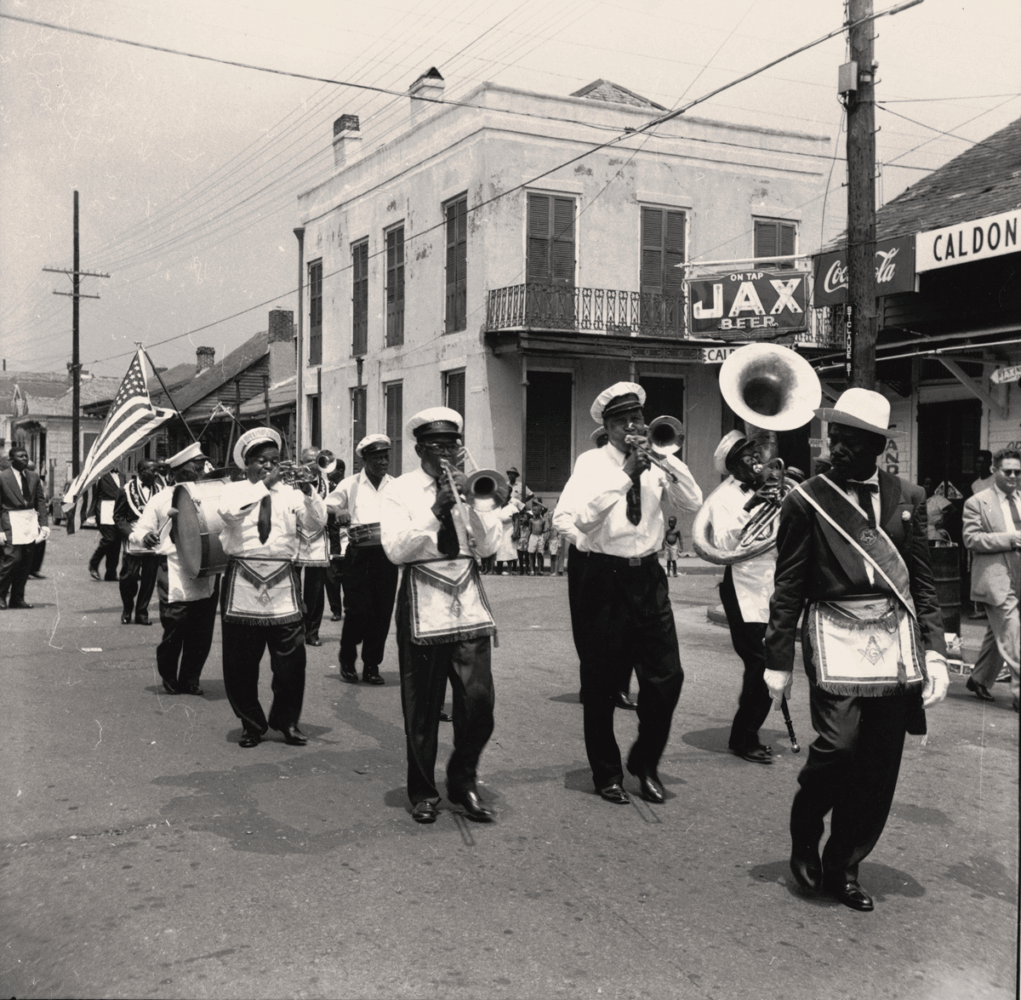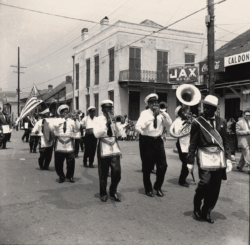Current Issue
Music in the Streets
A Closer Walk: New Orleans Music History, Block by Block is the 2025 Best in Digital Humanities award winner
Published: May 30, 2025
Last Updated: May 30, 2025

The John Bernard Photographic Archive at The Historic New Orleans Collection
A second line brass band led by a masonic lodge member in front of the Caldonia Restaurant & Bar.
The Louisiana Endowment for the Humanities has named A Closer Walk, a curated website that maps and documents musical and cultural sites in New Orleans, the 2025 Best in Digital Humanities award winner.
Organized in three categories—places, tours, and lagniappe—A Closer Walk contains interactive maps, virtual tours, audio, video, still photographs, and text. Future features will include 3D modeling. A Closer Walk pinpoints and contextualizes locations worthy of recognition and preservation and acknowledges structures that no longer exist. Often woven into neighborhoods, the landmarks include music venues, musicians’ homes, places of worship, recording studios, and street corners. So far, singer-songwriter Gram Parsons’ grave in Metairie is the only A Closer Walk entry beyond Orleans Parish. Future entries may also venture out of New Orleans proper, because the city’s music doesn’t end at the parish line.
Jordan Hirsch became A Closer Walk’s editor shortly after the site’s launch in 2017. “The idea is to tell these stories about New Orleans music by pegging them to locations in the city,” he said. Hirsch gathers multimedia content, adding new material to the site with the help of experts such as Rick Coleman, the award-winning biographer of Fats Domino. Tulane University’s Hogan Jazz Archive and The Historic New Orleans Collection are among the sources that provide images and information. Hirsch also produces newly recorded oral histories and interviews.
The number of individual entries for A Closer Walk has doubled since the site’s debut. Currently, 157 entries highlight historic music venues such as Preservation Hall, the Dew Drop Inn, and Tipitina’s; the homes of musicians Fats Domino, Danny and Blue Lu Barker, Louis Armstrong, and Earl Palmer; Cosimo Matassa’s three recording studios and Allen Toussaint and Marshall Sehorn’s Sea-Saint Studio; and the One Stop Record Shop. The site adds eight to twelve entries a year.
“Where do people turn to for neighborhood-level history?”
Hurricane Katrina and the destruction and displacement wrought by the ensuing flood heightened awareness of endangered historical sites, Hirsch said. “When the elders in the community are gone, when the face of the neighborhood is changing, where is that body of knowledge going to go?” he asked. “Where do people turn to for neighborhood-level history?”
A collective of music and culture advocates created what would become A Closer Walk. Writer and Ponderosa Stomp associate Alison Fensterstock began the digital mapping of landmarks in 2012. Some years later Ponderosa Stomp principals Aimee Bussells and Ira Padnos connected with David Freedman, the late general manager of New Orleans’s internationally known community radio station WWOZ. Freedman linked the Ponderosa Stomp people with filmmaker, writer, editor, and historian Kevin McCaffrey at E/Prime Media, and author and philanthropist Randy Fertel. As president of the Fertel Foundation and Ruth U. Fertel Foundation, Fertel supports many arts, education, and environmental organizations, including Artist Corps New Orleans and A Closer Walk.
Freedman and Fertel had already initiated a digital mapping project for traditional jazz sites, whereas the Ponderosa Stomp focused on post-World War II rhythm-and-blues landmarks. “David Freedman saw that these different groups of people had compatible interests,” Hirsch said. “He brought them together to form a more comprehensive picture.”
Hirsch pointed out that, before A Closer Walk, “there wasn’t a centralized repository for accurate information about New Orleans music history. There are [archival] institutions—the Hogan and HNOC, for example—which are essential—but they’re not designed for an average person to search for something and find a quick answer. We thought A Closer Walk could solve an unaddressed need.”
Local and national media outlets—including the New York Times, Axios, and the Times-Picayune/New Orleans Advocate—have cited A Closer Walk as a source for stories about the 2024 fire at Piety Street Recording; the 2024 reopening of the historic Dew Drop Inn; and the 2021 collapse of the Louis Armstrong–connected Karnofsky Shop building during Hurricane Ida.
“People are using the site as we’d hoped they would, as a dependable, go-to resource,” Hirsch said.
LEH’s biennial Best in Digital Humanities award honors online humanities projects such as websites, online exhibitions, and podcasts. A Closer Walk seeks to provide a single comprehensive and easily accessible source for New Orleans music and culture information. Learn more at acloserwalknola.com.
John Wirt is the author of the New Orleans music biography Huey “Piano” Smith and the Rocking Pneumonia Blues. He’s also written thousands of music and film features and reviews for newspapers and magazines.
